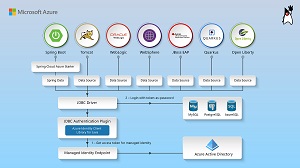News
Spring Cloud Azure 4.5 Furthers Microsoft's 'Passwordless' Push
Microsoft's journey to a passwordless future is reflected in the new stable release of Spring Cloud Azure v4.5.
"The 4.5.0 release focused on improving support for passwordless connections," the dev team said in a Dec. 16 announcement. "This release is our first stable version to support passwordless connections to Azure Database for MySQL and Azure Database for PostgreSQL."
 [Click on image for larger view.] Azure Passwordless Connections from Java Apps to Data Services (source: Microsoft).
[Click on image for larger view.] Azure Passwordless Connections from Java Apps to Data Services (source: Microsoft).
Microsoft has for years been aiming for a passwordless future for its accounts. In the December 2020 article "A breakthrough year for passwordless technology," it said, "Passwords are a hassle to use, and they present security risks for users and organizations of all sizes, with an average of one in every 250 corporate accounts compromised each month."
In September 2021, in the article, "The passwordless future is here for your Microsoft account," the company said:
Nobody likes passwords. They're inconvenient. They're a prime target for attacks. Yet for years they've been the most important layer of security for everything in our digital lives -- from email to bank accounts, shopping carts to video games.
We are expected to create complex and unique passwords, remember them, and change them frequently, but nobody likes doing that either. In a recent Microsoft Twitter poll, one in five people reported they would rather accidentally 'reply all' -- which can be monumentally embarrassing -- than reset a password.
Thus the steady infusion of passwordless tech into its products, with the latest being Spring Cloud Azure, described as an open source project (from VMware, though the GitHub repo is under Microsoft) that provides seamless Spring integration with Azure services, giving developers a Spring-idiomatic way to connect and consume Azure services by using only a few lines of configuration, requiring minimal code changes.
"The Spring Cloud Azure team will continue to focus on passwordless features," the dev team said in last week's announcement. "Azure SQL Database, Azure Cosmos DB, Azure Redis, Azure Service Bus JMS, and other services will support passwordless connections in the future."
The post explains how to connect to Azure Database for MySQL and PostgreSQL via passwordless connections and lists a few other tweaks the dev team made, with everything documented in the release notes. In addition the whole Azure passwordless story is detailed in November guidance titled "Passwordless connections for Azure services."
About the Author
David Ramel is an editor and writer at Converge 360.